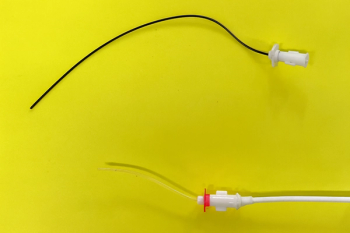
Importance of proteinuria and hypertension in chronic kidney disease (Proceedings)
Chronic kidney disease (CKD) is the term used to replace the older terms of chronic renal failure and renal insufficiency. This recognizes that CKD has a spectrum of severity from asymptomatic kidney disease to end stage uremia. Although CKD tends to be stable over the short term, it tends to progress to end-stage renal failure over months to years in most animals with CKD.
Chronic kidney disease (CKD) is the term used to replace the older terms of chronic renal failure and renal insufficiency. This recognizes that CKD has a spectrum of severity from asymptomatic kidney disease to end stage uremia. Although CKD tends to be stable over the short term, it tends to progress to end-stage renal failure over months to years in most animals with CKD. In the IRIS (International Renal Interest Society) staging system, CKD is classified into stages based on stable serum creatinine concentration and into sub stages based on level of proteinuria and hypertension.
Dietary Treatment of Chronic Kidney Disease
Although dietary therapy is a foundational part of treatment of CKD, dietary treatment of early CKD in dogs and cats continues to be controversial with respect to what dietary components are important to prevent progressive renal functional loss and uremia.1 Recent randomized clinical trials show that renal diets result in lower mortality from uremic crises and uremic death compare to maintenance diets in both dogs and cats with stage 2-3 CKD. It is not known exactly why renal diets are beneficial in these 2 clinical trials. Reasons that renal diets may be beneficial include restriction in dietary protein or phosphorus content, -3 fatty acid supplementation of the diet, alkalinizing nature of the diet, potassium content (cats) or other factors. There is no proof that dietary protein restriction independent of phosphorus restriction slows progression of CKD in dogs and cats. Dietary phosphorus restriction slows progression of induced models of CKD in dogs. Diets high in -3 fatty acids (menhaden fish oil) are beneficial in treatment of some models of CKD and immune-mediated GN compared to diets supplemented with -6 fatty acids.
It is also important that dogs and cats with CKD maintain adequate caloric intake to avoid protein-calorie malnutrition. Gradual transition to the renal diet over 2-4 weeks resulted in excellent acceptance of the diet in cats with stage 2-3 CKD in one clinical trial. Dogs and cats with stage 4 CKD often fail to eat sufficient food voluntarily, regardless of the palatability or nutrient content. Monitoring for evidence of protein-calorie malnutrition should include monitoring for weight loss, hypoalbuminemia, anemia, poor hair coat quality, muscle wasting and declining body condition scores. Diet consumption may be encouraged by minimizing uremia by maintaining hydration, heating the food to room temperature, adding small amounts of water, tuna water or clam juice, or adding garlic powder.
Hypertension and CKD
Hypertension and low level proteinuria are relatively common in dogs and cats with CKD. In the IRIS staging system, CKD is classified into sub stages based on proteinuria and hypertension. These comorbid factors may contribute to progression of the renal dysfunction. In dogs with spontaneous CKD, both proteinuria and hypertension were predictors of progressive renal dysfunction.In one study, 19% of cats with CKD were hypertensive. The mechanism of hypertension in CKD is multifactorial and probably includes activation of renin-angiotensin-aldosterone system, sympathetic hyperactivity, and renal sodium retention. Target organs for hypertensive injury include the eye, brain, heart and kidney. Hypertension may contribute to progression of CKD and dogs with hypertension are more likely to die of renal disease. Cats with hypertension may present with acute blindness and pupil dilation from retinal hemorrhage and detachment, or with seizures from neurologic complications of hypertension..
Dogs with CKD loose the normal autoregulatory capacity of the afferent and efferent arterioles that normally adjusts renal blood flow and glomerular filtration rate (GFR) over blood pressures between approximately 60 to 150 mmHg. Therefore, in animals with CKD, GFR is directly related to systemic blood pressure. Increases in blood pressure result in increased GFR. Likewise, decreases in systemic blood pressure result in decreased GFR. The two main clinical applications of this loss of autoregulatory capacity relate to dehydration and hypertension. Dehydration can lower mean BP, which directly reduces GFR in patients with CKD. Therefore, maintenance of hydration status and BP is an important for effective management of CKD. Maintenance of adequate hydration may be accomplished by feeding canned diets, adding supplemental water to canned diets, subcutaneous fluid therapy, or even use of feeding tubes such as PEG tubes or esophagostomy tubes.
The lack of autoregulation also means that elevated systemic blood pressure is transmitted into the glomeruli (intraglomerular hypertension) potentially resulting in glomerular injury and progression of CKD. Treatment of systemic hypertension should be considered with sustained systolic blood pressures above 160 mmHg. Some research studies suggest that use of ACE inhibitors (ACEI: enalapril or benazepril) may slow the rate of decline of the renal function in animals with induced CKD; therefore, some nephrologists suggest using an ACE inhibitor even if the animal has low to moderate risk of hypertensive end organ damage. Similarly animals which are borderline proteinuric might benefit from ACEI, although this needs to be confirmed through prospective clinical trials. One should monitor serum creatinine for declines in renal function within 5-7 days of any changes in anti-hypertensives. Control of hypertension may result in small increases in serum creatinine concentration (<0.5 mg/dl), but rarely a marked worsening of the azotemia may occur indicating an adverse drug reaction.
The recommended approach to treatment of hypertension from renal disease varies with dogs and cats. For dogs with CKD, ACE inhibitors should be initiated first (e.g., enalapril at 0.5 mg/kg PO q 12 h or benazepril at 0.5 mg/kg PO q 24h), and then double the dose if not effective. If hypertension still is not controlled, then add amlodipine (0.2 mg/kg PO q 12-24 h). For cats, amlodipine should be the initial antihypertensive (0.18-0.25 mg/kg or 0.625-1.25 mg/cat PO q 24 h), then increase the dose up to 0.5 mg/kg/day if it is not effective. If hypertension still is not controlled, then an ACEI such as Benazepril should be added to the amlodipine. Benazepril dosage for cats is 0.5 mg/kg once daily and there is no need for dosage reduction based on degree of renal dysfuction. Amlodipine is generally more effective for controlling blood pressure in animals with malignant hypertension and amlodipine is considered the preferred antihypertensive in cats. However, control of hypertension may not preserve renal function due to changes in intraglomerular pressures. In feline CKD, proteinuria that persists despite control of hypertension is important in progression of CKD. Lifelong serial monitoring of blood pressure for patients on anti-hypertensive medication is essential.
Proteinuria and CKD
Proteinuria is a negative prognostic indicator in dogs and cats with CKD. Recent studies in cats have shown that even low levels of proteinuria (UP/C ratio >0.2), which were previously thought to be clinical irrelevant, may be related to poor long term survival. However there is significant overlap of the magnitude of between cats with progressive renal disease and those which have stable renal function. ACE inhibitors lower intraglomerular capillary pressures which may lessen proteinuria, thereby potentially slowing progression of CKD.
ACE inhibitors lessen proteinuria in dogs and cats with spontaneous renal diseases. Benazepril treatment of cats with CKD resulted in significant reduction in severity of proteinuria. For dogs with protein losing nephropathy, treatment with enalapril versus placebo reduced proteinuria and slowed progression of CKD. It is not definitively known if benazepril is equally effective as enalapril in overtly proteinuric dogs. However, benazepril has the advantage of not being renal excreted, thus dosage adjustments are not required with more advanced stages of CKD. An additional advantage is that benazepril may be dosed once daily versus twice daily for enalapril. An ACVIM panel consensus statement on proteinuria recommends treatment of dogs with UP/C > 0.5 and cats with UP/C > 0.4 with a renal diet and ACE inhibitors.
Administration of benazepril was evaluated in cats with CKD in 2 recent clinical trials. Benazepril administration resulted in reduction of proteinuria and was well tolerated in cats with CKD. Both studies failed to demonstrate that ACE inhibition with benazepril slowed progression of CKD in cats. However the small number of cats in the studies, limited study duration, and lack of consistent monitoring for hypertension limited the power of these studies to detect or exclude a survival benefit from ACE inhibitors in cats with CKD. Further studies are needed to determine if administration of ACE inhibitors slows progression of CKD in dogs and cats and relative efficacy of benazepril versus enalapril. In another recent study, treatment of hypertensive CKD cats with amlodipine besylate resulted in a significant reduction in UPC ratio; however persistent proteinuria in spite of amlodipine therapy was associated with shorter survival times.
References
Polzin DJ, Osborne CA, Ross S. Chronic kidney disease, in Textbook of veterinary internal medicine: diseases of the dog and cat, ed. Ettinger SJ and Feldman EC, Elsevier Saunders, St. Louis, 2005, 1756-1785
Jacob F, Polzin DJ, Osborne CA, et al. Clinical evaluation of dietary modification for treatment of spontaneous chronic renal failure in dogs. J Am Vet Med Assoc 2002;220:1163-1170.
Ross S, Osborne CA, Polzin DJ, et al. Clinical evaluation of dietary modification for treatment of spontaneous kidney disease in cats. J Am Vet Med Assoc 2006;229:949-957.
Brown SA, Crowell WA, Barsanti JA, et al. Beneficial effects of dietary mineral restriction in dogs with marked reduction of functional renal mass. J Am Soc Nephrol 1991;1:1169-1179.
Brown SA, Brown CA, Crowell WA, et al. Effects of dietary polyunsaturated fatty acid supplementation in early renal insufficiency in dogs. Journal of Laboratory & Clinical Medicine 2000;135:275-286.
Brown SA, Finco DR, Brown CA. Is there a role for dietary polyunsaturated fatty acid supplementation in canine renal disease? J Nutr 1998;128:2765S-2767S.
Jacob F, Polzin DJ, Osborne CA, et al. Association between initial systolic blood pressure and risk of developing a uremic crisis or of dying in dogs with chronic renal failure. J Am Vet Med Assoc 2003;222:322-329.
Syme HM, Barber PJ, Markwell PJ, et al. Prevalence of systolic hypertension in cats with chronic renal failure at initial evaluation. J Am Vet Med Assoc 2002;220:1799-1804.
Jacob F, Polzin DJ, Osborne CA, et al. Evaluation of the association between initial proteinuria and morbidity rate or death in dogs with naturally occurring chronic renal failure. J Am Vet Med Assoc 2005;226:393-400.
Stiles J, Polzin DJ, Bistner SI. The prevalence of retinopathy in cats with systemic hypertension and chronic renal failure or hyperthyroidism. J Am Anim Hosp Assoc 1994;30:564-572.
Brown SA, Brown CA, Jacobs G, et al. Effects of the angiotensin converting enzyme inhibitor benazepril in cats with induced renal insufficiency. Am J Vet Res 2001;3:375-383.
Brown SA, Finco DR, Brown CA, et al. Evaluation of the effects of inhibition of angiotensin converting enzyme with enalapril in dogs with induced chronic renal insufficiency. Am J Vet Res 2003;64:321-327.
Henik RA, Snyder PS, Volk LM. Treatment of Systemic Hypertension in Cats with Amlodipine Besylate. J Am Anim Hosp Assoc 1997;33:226-234.
Mathur S, Syme H, Brown CA, et al. Effects of the calcium channel antagonist amlodipine in cats with surgically induced hypertensive renal insufficiency. Am J Vet Res 2002;63:833-839.
Mathur S, Brown CA, Dietrich UM, et al. Evaluation of a technique of inducing hypertensive renal insufficiency in cats. Am J Vet Res 2004;65:1006-1013.
Snyder PS. Amlodipine: a randomized, blinded clinical trial in 9 cats with systemic hypertension. J Vet Intern Med 1998;12:157-162.
King JN, Strehlau G, Wernsing J, et al. Effect of renal insufficiency on the pharmacokinetics and pharmacodynamics of benazepril in cats. J Vet Pharmacol Therap 2002;25:371-378.
King JN, Gunn-Moore DA, Tasker S, et al. Tolerability and efficacy of benazepril in cats with chronic kidney disease. J Vet Intern Med 2006;20:1054-1064.
Mizutani H, Koyama H, Watanabe T, et al. Evaluation of the clinical efficacy of benazepril in the treatment of chronic renal insufficiency in cats. J Vet Intern Med 2006;20:1074-1079.
Jepson RE, Elliott J, Brodbelt D, et al. Effect of control of systolic blood pressure on survival in cats with systemic hypertension. J Vet Intern Med 2007;21:402-409.
Syme HM, Markwell PJ, Pfeiffer D, et al. Survival of cats with naturally occurring chronic renal failure is related to severity of proteinuria. J Vet Intern Med 2006;20:528-535.
Elliott J, Syme HM. Proteinuria in chronic kidney disease in cats--prognostic marker or therapeutic target? J Vet Intern Med 2006;20:1052-1053.
Grauer GF, Greco DS, Getzy DM, et al. Effects of enalapril versus placebo as a treatment for canine idiopathic glomerulonephritis. J Vet Intern Med 2000;14:526-533.
Lees GE, Brown SA, Grauer GF, et al. Assessment and management of proteinuria in dogs and cats; 2004 ACVIM Forum Consensus Statement. J Vet Intern Med 2005;19:377-385.
Newsletter
From exam room tips to practice management insights, get trusted veterinary news delivered straight to your inbox—subscribe to dvm360.



